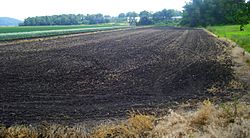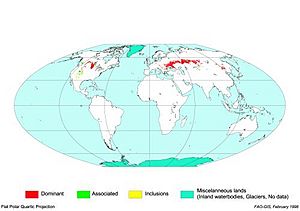Chernozem facts for kids
Quick facts for kids Chernozem |
|
|---|---|
| Chernozemic soil | |

|
|
| Used in | WRB, other |
| WRB code | CH |
| Profile | AhBC |
| Parent material | Loess |
| Climate | Humid continental |
Chernozem (which means "black soil" in Russian) is a very special type of black-colored soil. It's known for being super fertile, meaning it's great for growing plants and crops. This is because it has a lot of humus, which is decayed plant and animal matter (from 4% to 16%). It also contains important nutrients like phosphoric acids, phosphorus, and ammonia.
Chernozem can hold a lot of water, which helps plants grow well. This makes it possible to get high agricultural yields, meaning lots of crops from the land. Chernozems are also recognized as an important soil type by the World Reference Base for Soil Resources (WRB).
Where is Chernozem Found?
The name "Chernozem" comes from Russian words meaning "black earth." This rich, black soil was first studied by a Russian geologist named Vasily Dokuchaev in 1883. He found it in the grassy plains, or steppes, of European Russia.
Chernozems cover a huge area, about 230 million hectares around the world. There are two main "chernozem belts." One stretches across Eurasia, starting from eastern Croatia and going through countries like Serbia, Bulgaria, Romania, Moldova, and Ukraine. It continues into central and southern Russia and even into Siberia.
The second main belt is in North America. It goes from the Canadian Prairies in Manitoba down through the Great Plains of the US, reaching as far south as Kansas. You can also find similar soils in Texas and Hungary.
The thickness of the chernozem layer can be very different. It can be just a few centimeters thick, or it can be as deep as 1.5 meters (about 60 inches) in places like Ukraine and the Red River Valley in the northern US and Canada.
You can also find smaller amounts of chernozem in other places, like in Poland (about 1% of its land) and in Northeast China, near Harbin. In Australia, the only true chernozem is found around Nimmitabel, and it's some of the richest soil there.
In Ukraine, this soil is called chornozem. For a long time, it was illegal to sell agricultural land there. However, the soil itself was sometimes illegally dug up and sold, often transported by trucks. This was a big problem because the soil is so valuable for farming.
How Chernozem Forms
Scientists have studied how Chernozem forms for a long time. In the past, people thought its formation was mostly due to climate conditions from thousands of years ago.
However, more recent ideas suggest that human activities might have played a role too. For example, some scientists believe that ancient humans burning plants could have helped create some types of Chernozem. When plants are burned, it can change the soil's properties, making it darker and richer. This is because certain minerals in the soil can change when heated by fires.
Also, some Chernozems contain a lot of "black carbon," which comes from charred (burned) plant material. This suggests that fires, possibly started by humans, contributed to their formation. Because of these different ideas, the term Chernozem can describe various types of black soils that look similar but might have formed in different ways over time.
See also
 In Spanish: Chernozem para niños
In Spanish: Chernozem para niños


